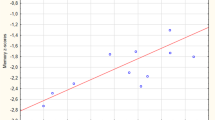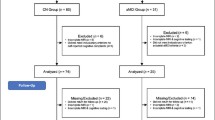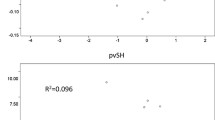Abstract
Fully automated magnetic resonance imaging (MRI)-based volumetry may serve as biomarker for the diagnosis in patients with mild cognitive impairment (MCI) or dementia. We aimed at investigating the relation between fully automated MRI-based volumetric measures and neuropsychological test performance in amnestic MCI and patients with mild dementia due to Alzheimer’s disease (AD) in a cross-sectional and longitudinal study. In order to assess a possible prognostic value of fully automated MRI-based volumetry for future cognitive performance, the rate of change of neuropsychological test performance over time was also tested for its correlation with fully automated MRI-based volumetry at baseline. In 50 subjects, 18 with amnestic MCI, 21 with mild AD, and 11 controls, neuropsychological testing and T1-weighted MRI were performed at baseline and at a mean follow-up interval of 2.1 ± 0.5 years (n = 19). Fully automated MRI volumetry of the grey matter volume (GMV) was performed using a combined stereotactic normalisation and segmentation approach as provided by SPM8 and a set of pre-defined binary lobe masks. Left and right hippocampus masks were derived from probabilistic cytoarchitectonic maps. Volumes of the inner and outer liquor space were also determined automatically from the MRI. Pearson’s test was used for the correlation analyses. Left hippocampal GMV was significantly correlated with performance in memory tasks, and left temporal GMV was related to performance in language tasks. Bilateral frontal, parietal and occipital GMVs were correlated to performance in neuropsychological tests comprising multiple domains. Rate of GMV change in the left hippocampus was correlated with decline of performance in the Boston Naming Test (BNT), Mini-Mental Status Examination, and trail making test B (TMT-B). The decrease of BNT and TMT-A performance over time correlated with the loss of grey matter in multiple brain regions. We conclude that fully automated MRI-based volumetry allows detection of regional grey matter volume loss that correlates with neuropsychological performance in patients with amnestic MCI or mild AD. Because of the high level of automation, MRI-based volumetry may easily be integrated into clinical routine to complement the current diagnostic procedure.



Similar content being viewed by others
References
Chetelat G, Baron JC (2003) Early diagnosis of Alzheimer’s disease: contribution of structural neuroimaging. Neuroimage 18:525–541
Golebiowski M, Barcikowska M, Pfeffer A (1999) Magnetic resonance imaging-based hippocampal volumetry in patients with dementia of the Alzheimer type. Dement Geriatr Cogn Disord 10:284–288
Kovacevic S, Rafii MS, Brewer JB (2009) High-throughput, fully automated volumetry for prediction of Mmse and Cdr decline in mild cognitive impairment. Alzheimer Dis Assoc Disord 23:139–145
Morra JH, Tu Z, Apostolova LG, Green AE, Avedissian C, Madsen SK, Parikshak N, Hua X, Toga AW, Jack CR Jr, Schuff N, Weiner MW, Thompson PM (2009) Automated 3d mapping of hippocampal atrophy and its clinical correlates in 400 subjects with Alzheimer’s disease, mild cognitive impairment, and elderly controls. Hum Brain Mapp 30:2766–2788
Apostolova LG, Thompson PM, Green AE, Hwang KS, Zoumalan C, Jack CR Jr, Harvey DJ, Petersen RC, Thal LJ, Aisen PS, Toga AW, Cummings JL, Decarli CS (2010) 3d comparison of low, intermediate, and advanced hippocampal atrophy in Mci. Hum Brain Mapp 31:786–797
Teipel SJ, Ewers M, Wolf S, Jessen F, Kolsch H, Arlt S, Luckhaus C, Schonknecht P, Schmidtke K, Heuser I, Frolich L, Ende G, Pantel J, Wiltfang J, Rakebrandt F, Peters O, Born C, Kornhuber J, Hampel H (2010) Multicentre variability of Mri-based medial temporal lobe volumetry in Alzheimer’s disease. Psychiatry Res 182:244–250
Ashburner J, Friston KJ (2005) Unified segmentation. Neuroimage 26:839–851
Lemaitre H, Crivello F, Grassiot B, Alperovitch A, Tzourio C, Mazoyer B (2005) Age- and sex-related effects on the neuroanatomy of healthy elderly. Neuroimage 26:900–911
Fonov VS, Evans AC, McKinstry RC, Almli CR, Collins DL (2009) Unbiased nonlinear average age-appropriate brain templates from birth to adulthood. NeuroImage 47:102
Eickhoff SB, Stephan KE, Mohlberg H, Grefkes C, Fink GR, Amunts K, Zilles K (2005) A new Spm toolbox for combining probabilistic cytoarchitectonic maps and functional imaging data. Neuroimage 25:1325–1335
Amunts K, Kedo O, Kindler M, Pieperhoff P, Mohlberg H, Shah NJ, Habel U, Schneider F, Zilles K (2005) Cytoarchitectonic mapping of the human amygdala, hippocampal region and entorhinal cortex: intersubject variability and probability maps. Anat Embryol (Berl) 210:343–352
Apostolova LG, Morra JH, Green AE, Hwang KS, Avedissian C, Woo E, Cummings JL, Toga AW, Jack CR Jr, Weiner MW, Thompson PM (2010) Automated 3d mapping of baseline and 12-month associations between three verbal memory measures and hippocampal atrophy in 490 Adni subjects. Neuroimage 51:488–499
van der Flier WM, van Buchem MA, Weverling-Rijnsburger AW, Mutsaers ER, Bollen EL, Admiraal-Behloul F, Westendorp RG, Middelkoop HA (2004) Memory complaints in patients with normal cognition are associated with smaller hippocampal volumes. J Neurol 251:671–675
Basso M, Yang J, Warren L, MacAvoy MG, Varma P, Bronen RA, van Dyck CH (2006) Volumetry of amygdala and hippocampus and memory performance in Alzheimer’s disease. Psychiatry Res 146:251–261
Pantel J, Schonknecht P, Essig M, Schroder J (2004) Distribution of cerebral atrophy assessed by magnetic resonance imaging reflects patterns of neuropsychological deficits in Alzheimer’s dementia. Neurosci Lett 361:17–20
Pantel J, Schroder J, Schad LR, Friedlinger M, Knopp MV, Schmitt R, Geissler M, Bluml S, Essig M, Sauer H (1997) Quantitative magnetic resonance imaging and neuropsychological functions in dementia of the Alzheimer type. Psychol Med 27:221–229
Acknowledgments
We thank Mrs. Kirsten Huwald for her assistance in maintaining the database of this study. This study was partly conducted within the framework of the German Competence Network on Dementia, funded by the German Federal Ministry for Education and Research (Bundesministerium für Bildung und Forschung, BMBF), grant O1GI 0102.
Conflict of interest
L.S. is an employee of jung diagnostics GmbH where automated MRI-based volumetry was performed blinded for diagnosis. The other authors (S.A., R.B., M.E., J.T.L, H.J.) do not report any conflicts of interest or financial involvement with BBS medical services.
Author information
Authors and Affiliations
Corresponding author
Rights and permissions
About this article
Cite this article
Arlt, S., Buchert, R., Spies, L. et al. Association between fully automated MRI-based volumetry of different brain regions and neuropsychological test performance in patients with amnestic mild cognitive impairment and Alzheimer’s disease. Eur Arch Psychiatry Clin Neurosci 263, 335–344 (2013). https://doi.org/10.1007/s00406-012-0350-7
Received:
Accepted:
Published:
Issue Date:
DOI: https://doi.org/10.1007/s00406-012-0350-7




